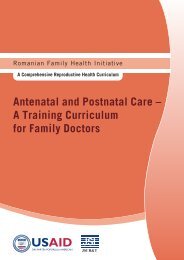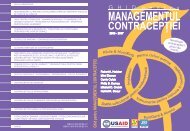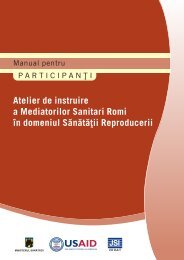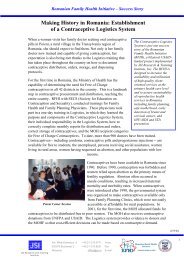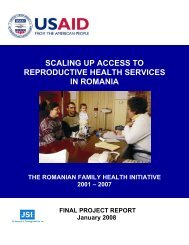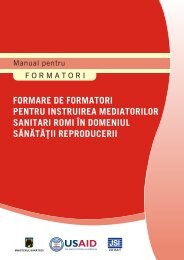Training of Roma Health Mediators in Reproductive Health
Training of Roma Health Mediators in Reproductive Health
Training of Roma Health Mediators in Reproductive Health
Create successful ePaper yourself
Turn your PDF publications into a flip-book with our unique Google optimized e-Paper software.
Participant document<br />
PRINCIPLES OF BREASTFEEDING<br />
Breastfeed<strong>in</strong>g should be the norm for all mothers. Assume that every mother will and<br />
can successfully breastfeed; reassure her that she is capable <strong>of</strong> produc<strong>in</strong>g plenty <strong>of</strong> milk<br />
for her baby. Young mothers who are hav<strong>in</strong>g their first baby are more likely to need<br />
<strong>in</strong>formation, support and help.<br />
The mother should give her breast to the baby as soon as possible, with<strong>in</strong> the hour(s)<br />
after he is born, when he seems to be ready. This <strong>in</strong>itial feed<strong>in</strong>g provides colostrum for<br />
the baby, which has very valuable antibodies to protect the baby from <strong>in</strong>fections.<br />
A baby shows he is ready to feed <strong>in</strong> several ways. He may:<br />
• Be wakeful and restless<br />
• Make small noises<br />
• Make hand-to-mouth movements or suck<strong>in</strong>g movements<br />
• Suck his f<strong>in</strong>gers or fist<br />
• Root for the breast (i.e. when his cheek is stroked, he turns his head to the side<br />
that is stroked and opens his mouth.)<br />
For the first few days the mother's breasts usually produce very little milk. This is<br />
normal. She should cont<strong>in</strong>ue to nurse her baby <strong>of</strong>ten-at least every two hours. The baby's<br />
suck<strong>in</strong>g will help her produce more milk.<br />
Encourage mothers to hold their babies naked aga<strong>in</strong>st their sk<strong>in</strong> (sk<strong>in</strong>-to-sk<strong>in</strong> contact) and<br />
to cover both with the same blanket.<br />
A mother needs to have her baby near her so that she can see and touch and respond to<br />
him. This helps her body to prepare for a breastfeed, and it helps her breast milk to<br />
flow. If a mother is frequently separated from her baby between feeds, the reflex may<br />
not work as well. In more and more maternities, mothers are stay<strong>in</strong>g <strong>in</strong> the same room<br />
with their babies (room-<strong>in</strong> system), which allows mothers to feed their babies on<br />
demand.<br />
The mother should feed her baby entirely on demand: she should suckle him whenever he<br />
wants and for as long as he wants. The advantages <strong>of</strong> breastfeed<strong>in</strong>g on demand are:<br />
• Breast milk `comes <strong>in</strong>' sooner<br />
• The baby ga<strong>in</strong>s weight faster<br />
• There are fewer difficulties such as breast engorgement<br />
• Breastfeed<strong>in</strong>g is more easily established<br />
Do not discourage the woman if she wishes to practice bedd<strong>in</strong>g-<strong>in</strong> (keep<strong>in</strong>g the baby <strong>in</strong><br />
bed with her). This makes it easier for her to breastfeed at night.<br />
153<br />
RFHI/JSI <strong>Roma</strong>nia <strong>Tra<strong>in</strong><strong>in</strong>g</strong> <strong>of</strong> RHMs <strong>in</strong> <strong>Reproductive</strong> <strong>Health</strong> Session 9: Breastfeed<strong>in</strong>g



